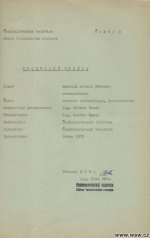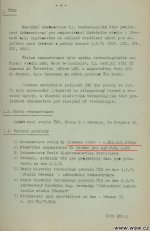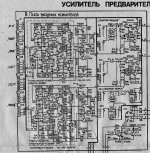Some will say that it is a problem with perception, but I trust my ears, they have rarely failed me, EXCEPT in ABX double blind tests set up by engineers and professors.
Thanks for admitting to us that you can't tell what is playing without peeking. I see you are still stuck on what you did 40 years ago too.*yawn*
IGNORANCE IS BLISS
Recording industry in the Eastern block was state owned and state had to have the best!
They used the same tools, John!
Studer C37s and 80s tape recorders, Studer consoles, mics by Neumann (U47, SM2, SM69, U49, U50, U87), Telefunken (250), Shoeps, AKG .. EMT plates, Neumann VMS cutting lathes, measurement equipment by Bruel&Kjaer.. you name it! Some Eastern equipment was very good as well, btw.
When it comes to putting out some LSD influenced rock music, sure, that one was kept away from state owned studios (from any studios, in fact), but classical ... mmm... I am still wondering what treasures Russians might have in their Melodiya vaults in Moscow.
One of my favourite live recordings of Louis Armstrong (I'm not a big fan of him, btw.) is this one, made in 1965 in Prague! Note the East German tube CMV563 Neumanns (M7 capsule, EC92 tube) on the stage 😉
http://www.discogs.com/Louis-Armstrong-Lucerna-1965-Lucerna-Hall-Prague-1965-Live/release/1736385
Here are a few docs about Siemens Austria console and Studer A80 delivery to Czech TV in '70s as a proof.
PMA, how could you know anything in detail about the audio quality of the '60's or 70's? You were behind the 'iron curtain'. ...
Recording industry in the Eastern block was state owned and state had to have the best!
They used the same tools, John!
Studer C37s and 80s tape recorders, Studer consoles, mics by Neumann (U47, SM2, SM69, U49, U50, U87), Telefunken (250), Shoeps, AKG .. EMT plates, Neumann VMS cutting lathes, measurement equipment by Bruel&Kjaer.. you name it! Some Eastern equipment was very good as well, btw.
When it comes to putting out some LSD influenced rock music, sure, that one was kept away from state owned studios (from any studios, in fact), but classical ... mmm... I am still wondering what treasures Russians might have in their Melodiya vaults in Moscow.
One of my favourite live recordings of Louis Armstrong (I'm not a big fan of him, btw.) is this one, made in 1965 in Prague! Note the East German tube CMV563 Neumanns (M7 capsule, EC92 tube) on the stage 😉
http://www.discogs.com/Louis-Armstrong-Lucerna-1965-Lucerna-Hall-Prague-1965-Live/release/1736385
Here are a few docs about Siemens Austria console and Studer A80 delivery to Czech TV in '70s as a proof.
Attachments
Here's the phono stage from 1985 by Soviet state owned manufacturer.
EDIT: Supply voltage - +/- 35V
EDIT: Supply voltage - +/- 35V
Attachments
Last edited:
John, if you're talking to me, then,
1. I think not.
2. Do I have to?
3. I didn't say anything about IC based design, except that keep mentioning faults of 741/301 etc. in 2014 is pointless.
I subscribe to modern discrete designs and use ICs only where appropriate or when there's no other choice. After reading your reasoning here, I also subscribe to minimum number of junctions. The last one is tough to follow, though .. 😉
1. I think not.
2. Do I have to?
3. I didn't say anything about IC based design, except that keep mentioning faults of 741/301 etc. in 2014 is pointless.
I subscribe to modern discrete designs and use ICs only where appropriate or when there's no other choice. After reading your reasoning here, I also subscribe to minimum number of junctions. The last one is tough to follow, though .. 😉
Here's what I was doing in my early 20's. Not much different to Neve's or any of the other stuff in the final analysis. I think it sounded good, but I would not say designs from that era sound better than well designed stuff from today (discrete or IC) when fed from a quality source. We know a lot more now, depsite what some people may say.
My new pre will be finished in a few weeks - I'll cover this and a few other things in the doc. 😉
My new pre will be finished in a few weeks - I'll cover this and a few other things in the doc. 😉
Attachments
Did you know that Sheffield Records shipped my Ultramaster (custom electronics with a Studer transport), to record the Moscow Philharmonic back in the mid 1980's? However an EARLY A80Vu was sort of OK. Later A80's had serious xover distortion in their line amps. I took the measurement evidence to Willi Studer, himself. That caused a commotion.
Yes, as the 70's turned into the 80's, the Studer electronics got worse and worse.
I liked their transports, however.
Yes, as the 70's turned into the 80's, the Studer electronics got worse and worse.
I liked their transports, however.
Their later transports use switched power supplies, processors etc, which, in turn, generate a lot of 'garbage'.
How can you say that, 😡? Competent engineers always have the situation well in hand, would never make such a 'mistake' ... 😉
How can you say that, 😡? Competent engineers always have the situation well in hand, would never make such a 'mistake' ... 😉
Hello Fas42,
Are you an Engineer.
Regards
Arthur
Yes, but non-practicing ... I would call myself a former software engineer, from an industry which is hopelessy mired in sloppy practices ...
Recording industry in the Eastern block was state owned and state had to have the best!
They used the same tools, John!
Studer C37s and 80s tape recorders, Studer consoles, mics by Neumann (U47, SM2, SM69, U49, U50, U87), Telefunken (250), Shoeps, AKG .. EMT plates, Neumann VMS cutting lathes, measurement equipment by Bruel&Kjaer.. you name it! Some Eastern equipment was very good as well, btw.
One of my favourite live recordings of Louis Armstrong (I'm not a big fan of him, btw.) is this one, made in 1965 in Prague! Note the East German tube CMV563 Neumanns (M7 capsule, EC92 tube) on the stage 😉
http://www.discogs.com/Louis-Armstrong-Lucerna-1965-Lucerna-Hall-Prague-1965-Live/release/1736385
Here are a few docs about Siemens Austria console and Studer A80 delivery to Czech TV in '70s as a proof.
Correct. I worked in Supraphon recording studios for some time, in the seventies, when I studied at the university. Studer A67 and A80 tape recorders, Neumann mikes, Dolby A rack systems.
I own a vinyl record of the Armstrong 1965 Prague concert, and also unreleased recordings from his visit to Prague.
You guys are still at 40 years ago, when it comes to actual circuit topology. Only IC processing improvements let you get as far as you have today, and I can still beat it, with modern designs.
Any proof here, except for audiophile mag reviews and ratings?
There were eastern audio equipment that stood above the western counterparts, don’t jump easily into conclusions.
Classic repertoire recordings from the eastern block are still praised today.
You can find some in “Brilliant” catalogue
Top quality recordings - Brilliant Classics
George
Classic repertoire recordings from the eastern block are still praised today.
You can find some in “Brilliant” catalogue
Top quality recordings - Brilliant Classics
George
Do you think an IC based design will beat this? Prove it!
I appreciate competitiveness as much as anyone, but the "Beat this" attitude really won't move the discussion meaningfully.
IC's benefit from really well matched components, the ability to make active solutions that are not practical as discrete parts and use very complex structures that really cannot be made using discrete parts. But you cannot run the high voltages and high currents that are possible with discrete parts. There is not single solution to every problem. The 3 or 4 transistor circuit of the old Neve or Ampex was an excellent solution at the time. If an IC could deliver the desired specs then the discretes would have been gone in an instant. The realities of commercial production for machines used to generate income are very different from consumer products.
I started my career working on computers built with discrete components. they were the fastest machines available in the mid 70's (CDC 6600 and 7600). However tunnel diode logic was transcended by ECL IC's not many years later and they vanished really quickly (as did Control Data). Even Lawrence Livermore's demand for the highest performance moved to IC's and MOS memory from core and discrete transistors, and not just for cost. In the height of the cold war cost had no meaning when designing nuclear weapons.
Discrete solutions still have a place and can do things not possible with current IC's but lets focus on specifics, not the "mine's bigger than yours" attitude that high end audio is rife with. It does nothing but polarize the discussions and yield no progress.
Where are your IC's, Bonsai? I use more IC's than you do.
I used them in the tone control/buffer stage that came after the volume control.
You will will be happy to note that I used a discrete JFET buffer between the volume control and the tone control. The reason was: Noise. The JFET buffer was quieter than an opamp with a 20k pot.
Now days, the JFET/opamp decision criteria is much more difficult - but thats only my view.
How can you say that, 😡? Competent engineers always have the situation well in hand, would never make such a 'mistake' ... 😉
What is that suppose to mean, do you think audio equipment is not designed by engineers, please explain why you have this attitude towards engineers and engineering that often comes out in statements similar to this?
What's in a bit of humour, 😉 ... I'm just having a gentle dig at those who just follow the standard rules, and don't stand back now and again - and try and look at the situation with fresh eyes ...
Want to have a bit of a laugh? I once was so fussy about a building going up that they tagged me "The Millimetre Kid" - I decided to give the workers some space, it wasn't worth the hassle ...
Want to have a bit of a laugh? I once was so fussy about a building going up that they tagged me "The Millimetre Kid" - I decided to give the workers some space, it wasn't worth the hassle ...
- Status
- Not open for further replies.
- Home
- Member Areas
- The Lounge
- John Curl's Blowtorch preamplifier part II



